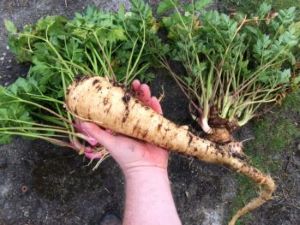By Jeanne Yacoubou, MS
In a recent article introducing perennial vegetables as a climate solution, The Vegetarian Resource Group briefly mentioned that unlike vegetables grown each year from seed in a typical backyard garden, perennials are planted only once and regrow by themselves for years – if not decades. We also noted that regular harvesting is necessary to prevent most perennials from becoming weedy. But we didn’t discuss any other strategies to ensure success in a perennial garden.
Although it’s true that growing perennial vegetables is a lot like growing annual tomatoes, peppers, or squash, there are a few modifications to common gardening techniques that will make it easier. Here, we’ll share tips for success in perennial vegetable gardening.
Building soil health
When growing annuals, gardeners may get bumper crops by dousing the surface soil with fertilizer that may have an immediate effect but is prone to leaching during rain. With perennials, on the other hand, it’s vitally important to build soil health. Doing so is a never-ending, slow process, but it will be worth it.
Healthy soil contains legions of microbes that release plentiful nutrients to plant roots in exchange for the sugars that plants make. Healthy soil also has an increased water-holding capacity so deep-rooted perennials can reach moisture even in times of drought. An added benefit of deep roots is improved soil drainage and reduced erosion in times of heavy rains or flooding (which is becoming more frequent in a climate crisis).
There is no doubt that rich soil will yield immense returns on your long-term investment in the form of bountiful yields for years.
The best way to build soil health is to add compost regularly. If you don’t already, prepare your own compost by mixing high-nitrogen, green material (grass clippings, vegan food scraps (but no oils), and coffee grounds) with high-carbon, brown material (dried leaves, dried plant stalks, pine needles, and shredded newspaper) in a 1:2 ratio of browns to greens. Create a backyard pile that you turn frequently and keep moist or add to an enclosed tumbler.
Once it’s transformed into a black, crumbly soil after a month or more, depending on outside temperature, add to the surface of your garden plot. Do not mix it in because you want to keep the soil structure and microbial community intact. You may wish to spend 1-2 years building the soil health of your future garden plot – eliminating weeds as they sprout – before actual planting.
Growing perennial vegetables in poor soil
Building optimal soil may take a year or more. Unlike annuals which will not thrive in poor soil, certain perennial vegetables will. In fact, some perennials, such as goldenberry, do poorly in rich soil! So, you can get started perennial gardening right away no matter the soil condition if you’re really anxious to begin. Add compost regularly to the surface as you make it.
According to Eric Toensmeier, author of Perennial Gardening, these are some of the perennials that grow well in poor soil.
- Achira
- Chaya
- Mashua
- Moringa
- Pitpit
- Saltbrush
- Ulluco
Growing perennial vegetables in full shade
While most annuals need full sun, certain perennial vegetables thrive in shade. These are:
- Giant Solomon’s seal
- Katuk
- Linden
- Ramps
- Wood Nettle
General tips on planting perennial vegetables
Even experienced gardeners commit these errors occasionally. With perennials, observing them is even more important so you won’t lose plants.
- Leave recommended spacing between plants. Perennials will grow significantly in a few years and tend to crowd out each other. Transplanting them is not ideal since it disrupts soil structure.
- Mulch around the base of young plants immediately to deter weeds. Perennials are often slower to establish than annuals, so there’s no time to waste.
- Keep (or plant) a mowable strip of turf grass on either side of rhizomatous perennials. Some species, such as sunchokes, often spread aggressively underground unless constrained by such borders. Unless held in check, they may quickly dominate your garden.
- Blanch perennials to keep emerging shoots and leaves tender and milder in flavor. This practice may also encourage early growth in some plants such as rhubarb. To prevent breaking new stems, put an inverted planter or flower pot over the plant for a few days to reduce light, thereby slowing growth. Asparagus, sea kale, and garlic chives benefit from blanching this way.
- Provide extra-sturdy and larger structures for perennials in the bean and squash families, as well as yams, mashua, and Malabar spinach. These plants are longer-lived and possess more and heavier biomass than annual climbing vegetables, so they’ll need it.
- Choose an optimal site for planting to reduce disease pressure. Unlike annuals which can be rotated each year in your garden to prevent or minimize disease, perennials are meant to be planted only once. Research optimal soil condition, water requirements, and sun preference for each species and plant accordingly. Creating a polyculture of mixed species – and several different varieties of the same species – will also help lessen the opportunity for a disease to become established.
- If you grow certain perennial root crops known as plant/replant perennials, rotate them each year to decrease the chance of disease spread. Like garlic and potatoes, these are non-colony-forming root crops. Examples include aroids, arracacha, chufa, oca, skirret, and ulluco.
- Practice specialized techniques to stimulate seed germination. Unlike seeds of annual plants, perennial plant seeds are often slow to germinate. Research the plant species you plan to include. You may need to cold stratify and/or scarify before seeds will germinate. These techniques involve keeping seeds moist in the fridge for two months or rubbing them between sandpaper, respectively.
Key takeaways on perennial vegetable gardening
Perennial vegetables are climate foods that sequester carbon longer than annual vegetables. Many of the same techniques used in a conventional backyard summer garden are used to grow them successfully. There are important differences which are discussed here.


